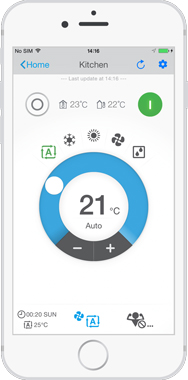Commercial ventilation systems
The rise in energy-efficient building designs is increasing the need for ventilation systems. Ventilation systems must also be installed into most commercial buildings now to meet current building regulations. Energy efficient buildings require more insulation to reduce heating and cooling loss. This means that the air inside your building lingers longer and becomes stale. The stale air also puts your building at a greater risk for allergies, residual odours, condensation, mould and more.
Below is a list of the most common sytems available:
Ducted AHU installations are mainly used in larger building applications and generally provide tempered fresh air to offices etc. the incoming fresh air is filtered then heated or cooled as necessary prior to being supplied to the space. The AHU’s are usually located in a common or various plant rooms throughout the building, one of the benefits of this type of system is that all the maintenance required is carried out from within the plant room and not within the space being conditioned, this is ideal for areas that are highly occupied or have high cleanliness levels such as hospitals etc. The extract air is removed from the space using a separate fan system; this system can remove air from a ceiling void or be connected to grilles in the ceiling via ductwork. As the air is not recirculated it is ideal for hospital or pharmaceutical installations where there can be no risk of cross contamination.
This type of system is similar to the previous except the extract air and fresh air are put through a form of heat exchanger prior to being exhausted and discharged into the space. In winter the warm air being extracted from the space heats the heat exchanger, this in turn heats the cooler fresh air being supplied back into the space, in summer the same principle acts in reverse. This type of system will provide cost savings to the previous type as the amount of energy being used to pre heat or cool the incoming fresh air is reduced. The AHU’s can be manufactured to suit any application from domestic to commercial. Both Daikin and Mitsubishi provide an internal ducted heat recovery fan coil unit which can communicate with there respective heat pump systems installed providing a packaged economic highly efficient HVAC installation.
We have previously described the function of a package type system, apart from being able to supply heated or cooled air, the systems we install have an option of an economiser, and this acts as a mixing box and joins the fresh air to the recirculated air via motorised dampers. The fresh air dampers can be adjusted to always provide a minimum amount of fresh air based on the occupancy of the space being conditioned, this eliminates the need for a separate ventilation system, the fresh air dampers are modulated using either dry bulb temperature or enthalpy control.
We can supply and fit a complete kitchen ventilation system which would be designed to suit your kitchen and cooking layouts. Most installations comprise of a canopy over the cooking equipment which is then connected to an extract fan and ductwork to discharge externally. Fresh air make up is usually mechanically provided and is either distributed via the canopy or through separate distribution grilles in the ceiling. There are a number of issues to consider during the design stage, these usually depend on the amount and type of cooking being carried out, the system will need to meet the requirements of the Environmental Health Officer which may also require planning approval, all of which we would be happy to discuss with you.
We can also design and provide a quotation for the gas supply to the cooking equipment LPG or natural gas, the gas interlock required to the ventilation system and also the hot and cold piped water services.
 Stay on top of your energy consumption and running costs with user-friendly control systems. We believe that climate control should be simple, intuitive, smart and energy efficient.
Stay on top of your energy consumption and running costs with user-friendly control systems. We believe that climate control should be simple, intuitive, smart and energy efficient.
Whether you are looking for a solution for your home or your business, we offer a variety of systems that will help you take control of your climate and provide optimal comfort.
With an online controller, you can take control of your climate from any location. Simply connect your unit to Wi-Fi and download the app. Available for iOS and Android, you can change the thermostat, set temperature schedules, review your energy consumption and develop your own “if this, then that” workflow.
Smart building management
We offer a variety of climate control systems to help you manage your building’s energy consumption efficiently and optimise your comfort.
Multi-site control
Centralise the control of your various climate zones by connecting your intelligent tablet controller to the cloud. Simultaneously monitor and benchmark multiple locations to reduce high energy consumption. Connect to the cloud and access your units from any location at any time. Intuitive touchscreen interface guarantees easy climate control.
Ideal for small to medium-sized commercial applications.
Building management system
We can provide intuitive and user-friendly BMS systems which integrate seamlessly with 3rd party equipment, so that you can control your climate, lighting, alarms and more with a single interface. Monitor your energy consumption, optimise your energy use and reduce your energy costs. Easy-to-use energy data trending and analytic tools leading to savings of up to 15{0ac3d56eea693ac2cfa2249648973a1cfbe39fc1280b0561f9d581ca114fac1e}.
Ideal for medium to large commercial applications.
Individual control systems
Individual control systems allow you to control your climate directly with user-friendly interfaces and scheduling functions. Intuitive interfaces make controlling your climate easy and contemporary designs blend in seamlessly with your interior. You can also keep track of your energy consumption with visual display graphs.
Ideal for small commercial applications.
Individual rooms
Adjust the temperature, operating mode, air purification and fans for individual rooms with the interactive thermostat.
Commercial heating systems
Heating can be provided using the equipment previously described in the comfort cooling section, there are however more traditional heating only systems available as follows:
We can install new or replace existing gas, LPG and oil fired boiler plant serving ‘wet’ type heating systems such as radiators, LPHW fan convectors and under floor heating. The boiler plant can also be used for producing the primary source for heating the buildings domestic hot water supply, as an alternative the hot water can be produced using a direct fired, gas, oil or LPG storage heater.
We can install all types of warm air heaters from domestic to industrial installations. We use Lennox warm air heaters for the smaller type domestic or office installations as they produce the most efficient condensing type burners, these units can also be fitted with cooling coils to provide heating and cooling if required. For the larger industrial and commercial installations we use Powrmatic heaters, these type of heaters can be free blowing or connected to ductwork, suspended from the roof structure or floor mounted or mounted externally. We can also replace any existing faulty or inefficient rooftop AHU/package unit with a bespoke roof top system; this can connect to the existing ductwork, gas and electrical supplies avoiding the need to replace complete systems, saving money and internal disruptions.
As an alternative to warm air we can supply and fit radiant tube heating systems, these are generally installed in buildings with large internal volumes and high air change rates, such as warehouses etc.
An air source heat pump is dimensioned to meet all your heating and hot water needs which for the average UK home accounts for 82{0ac3d56eea693ac2cfa2249648973a1cfbe39fc1280b0561f9d581ca114fac1e} of your total final energy use according to the Department for Energy and Climate Change (DECC) 2013 statistics. When you heat your property using a heat pump, your running costs are reduced to the amount of electricity required to run the heat pump, and because a heat pump is designed to produce at least 2.5 units of heat for 1 unit of input electricity, this can mean considerable savings to your energy bill if it is replacing oil, LPG or all-electric heating.
The Renewable Heat Incentive is now available and rewards householders investing in air source heat pumps with regular payments received in respect of the amount of heat energy produced by the heat pump. Unfortunately, the RHI does not cover Air to Air heat pumps.
Investment and Funding
The installation of an air source heat pump normally will require an investment of between £6,000 and £10,000, depending on different factors, such as the size of the property and the levels of energy demand. The amount of money that you save from introducing an air heat pump system will depend on the characteristics of your property, how warm you like to keep your house, etc. When converting from an oil boiler to an air source heat pump, our customers on average save between £600-£1000 a year.





